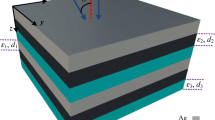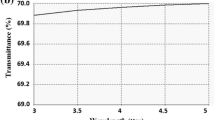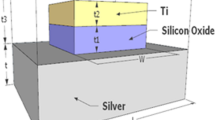Abstract
In this work, we investigate the photonic stop band of multilayers, which is the simplest possible 1D photonic crystal, using MIT electromagnetic equation propagation software. The transmission spectra were simulated, and the effect of the number of layers and the contrast in the dielectric constant on the photonic band gap was studied. The ZnO/SiO2 multilayer was fabricated using radio frequency magnetron sputtering. The refractive indices of ZnO and SiO2 were found from the absorption spectra. The transmission spectra of the photonic crystals with eleven layers were studied using a UV–visible spectrophotometer. A dip in the transmission spectra in the wavelength range of blue was observed. The experimental result matched the simulated transmission spectra. The cross-sectional view of the multilayers was observed using a field emission scanning electron microscope.










Similar content being viewed by others
References
R. Ghosh, K.K. Ghosh, R. Chakraborty, Narrow band filter using 1D periodic structure with defects for DWDM systems. Opt. Commun. 289, 75–80 (2013). https://doi.org/10.1016/j.optcom.2012.10.001
F. Scotognella et al., Metal oxide one dimensional photonic crystals made by RF sputtering and spin coating. Ceram. Int. 41(7), 8655–8659 (2015). https://doi.org/10.1016/j.ceramint.2015.03.077
K.X. Wang, Z. Yu, V. Liu, A. Raman, Y. Cui, S. Fan, Light trapping in photonic crystals. Energy Environ. Sci. 7(8), 2725–2738 (2014). https://doi.org/10.1039/c4ee00839a
T. Senn, J. Bischoff, N. Nüsse, M. Schoengen, B. Löchel, Fabrication of photonic crystals for applications in the visible range by nanoimprint lithography. Photonics Nanostructures Fundam. Appl. 9(3), 248–254 (2011). https://doi.org/10.1016/j.photonics.2011.04.007
P. Bermel, C. Luo, L. Zeng, L.C. Kimerling, J.D. Joannopoulos, Improving thin-film crystalline silicon solar cell efficiencies with photonic crystals. Opt. Express 15(25), 16986 (2007). https://doi.org/10.1364/oe.15.016986
B.K. Singh, S. Tiwari, M.K. Chaudhari, P.C. Pandey, Tunable photonic defect modes in one-dimensional photonic crystals containing exponentially and linearly graded index defect. Optik (Stuttg) 127(16), 6452–6462 (2016). https://doi.org/10.1016/j.ijleo.2016.04.067
L. Fan, W. Li, W. Jin, M. Orenstein, S. Fan, Maximal nighttime electrical power generation via optimal radiative cooling. Opt. Express 28(17), 25460 (2020). https://doi.org/10.1364/oe.397714
W. Li, M. Dong, L. Fan, J.J. John, Z. Chen, S. Fan, Nighttime radiative cooling for water harvesting from solar panels. ACS Photonics 8(1), 269–275 (2021). https://doi.org/10.1021/acsphotonics.0c01471
H.S. Dutta, A.K. Goyal, V. Srivastava, S. Pal, Coupling light in photonic crystal waveguides: a review. Photonics Nanostructures - Fundam. Appl. 20, 41–58 (2016). https://doi.org/10.1016/j.photonics.2016.04.001
B.K. Singh, P.C. Pandey, A study of optical reflectance and localization modes of 1-D fibonacci photonic quasicrystals using different graded dielectric materials. J. Mod. Opt. 61(11), 887–897 (2014). https://doi.org/10.1080/09500340.2014.914587
P. Bienstman, R. Baets, Optical modelling of photonic crystals and VCSELs using eigenmode expansion and perfectly matched layers. Opt. Quantum Electron. 33(4–5), 327–341 (2001). https://doi.org/10.1023/A:1010882531238
A.F. Oskooi, D. Roundy, M. Ibanescu, P. Bermel, J.D. Joannopoulos, S.G. Johnson, Meep: a flexible free-software package for electromagnetic simulations by the FDTD method. Comput. Phys. Commun. 181(3), 687–702 (2010). https://doi.org/10.1016/j.cpc.2009.11.008
G. Rosolen and A. Cola,Fabrication of photonic crystal structures by electron beam lithography, Conf. Optoelectron. Microelectron. Mater. Devices, Proceedings, COMMAD. pp. 66–69, (2006). doi: https://doi.org/10.1109/COMMAD.2006.4429881.
S.H. Kim, K.D. Lee, J.Y. Kim, M.K. Kwon, S.J. Park, Fabrication of photonic crystal structures on light emitting diodes by nanoimprint lithography. Nanotechnology 18(5), 055306 (2007). https://doi.org/10.1088/0957-4484/18/5/055306
M. Nishimoto, K. Ishizaki, K. Maekawa, Y. Liang, K. Kitamura, S. Noda, Fabrication of photonic crystal lasers by MBE air-hole retained growth. Appl. Phys. Express 7(9), 092703 (2014). https://doi.org/10.7567/APEX.7.092703
M. Duneau, F. Delyon, M. Audier, Holographic method for a direct growth of three-dimensional photonic crystals by chemical vapor deposition. J. Appl. Phys. 96(5), 2428–2436 (2004). https://doi.org/10.1063/1.1776322
T. Kawashima, Autocloning technology: fabrication method for photonic crystals based on sputtering process. American Institute of Physics. 560(1), 115–122 (2003). https://doi.org/10.1063/1.1372721
X. Meng et al., Design and fabrication of photonic crystals in epitaxy-free silicon for ultrathin solar cells. To cite this version : HAL Id : hal-00666247 Design and fabrication of photonic crystals in epitaxial free silicon for ultrathin solar cells (2012)
M.H. Suhail, G.M. Rao, S. Mohan, Dc reactive magnetron sputtering of titanium-structural and optical characterization of TiO2 films. J. Appl. Phys. 71(3), 1421–1427 (1992). https://doi.org/10.1063/1.351264
G. Holmén, H. Jacobsson, The influence of oxygen on SiO2 sputtering. J. Appl. Phys. 68(6), 2962–2965 (1990). https://doi.org/10.1063/1.346431
P. Pansila, N. Witit-Anun, S. Chaiyakun, Influence of sputtering power on structure and photocatalyst properties of DC magnetron sputtered TiO2 thin film. Procedia Eng. 32, 862–867 (2012). https://doi.org/10.1016/j.proeng.2012.02.024
K. Takamura, Y. Abe, K. Sasaki, Influence of oxygen flow ratio on the oxidation of Ti target and the formation process of TiO2 films by reactive sputtering. Vacuum 74(3–4), 397–401 (2004). https://doi.org/10.1016/j.vacuum.2004.01.006
N.A. Mortensen, Photonic crystal fibres: mapping Maxwell’s equations onto a Schrödinger equation eigenvalue problem. J. Eur. Opt. Soc. 1, 1–7 (2006). https://doi.org/10.2971/jeos.2006.06009
A. Macleod, The quarterwave stack: 2 properties. SVC Fall Bull. 16(3), 16–21 (2012)
S. John, V. Geetha, and M. Francis, “Effect of pH on the optical and structural properties of SnS prepared by chemical bath deposition method,” IOP Conf. Ser. Mater. Sci. Eng. vol. 872, no. 1, (2020). doi: https://doi.org/10.1088/1757-899X/872/1/012139.
H.S. Bolarinwa et al., Determination of optical parameters of zinc oxide nanofibre deposited by electrospinning technique. J. Taibah Univ. Sci. 11(6), 1245–1258 (2017). https://doi.org/10.1016/j.jtusci.2017.01.004
S. Fan, Z. Wang, D.A.B. Miller, P.R. Villeneuve, H.A. Haus, J.D. Joannopoulos, Photonic crystal for communication applications. Act. Passiv. Opt. Compon. WDM Commun. II 4870(1), 339 (2002)
Acknowledgements
The authors would like to acknowledge the Department of Science and Technology (DST-FIST), India, for the financial support rendered in setting up the research lab (grant number SR/FST/College-237/2014 (C)) and the University Grants Commission, India, for providing research funds through a minor project (grant number MRP(S)-0191/12–13/KLCA021/UGC-SWRO).
Author information
Authors and Affiliations
Contributions
SJ was involved in methodology, validation, investigation, writing—original draft. KAL contributed to resources. APRM was involved in supervision. VG contributed to conceptualization, formal analysis, supervision, writing—review and editing.
Corresponding author
Ethics declarations
Conflict of interest
The authors declare that they have no known competing financial interests or personal relationships that could have appeared to influence the work reported in this paper.
Additional information
Publisher's Note
Springer Nature remains neutral with regard to jurisdictional claims in published maps and institutional affiliations.
Rights and permissions
Springer Nature or its licensor (e.g. a society or other partner) holds exclusive rights to this article under a publishing agreement with the author(s) or other rightsholder(s); author self-archiving of the accepted manuscript version of this article is solely governed by the terms of such publishing agreement and applicable law.
About this article
Cite this article
John, S., Lazar, K.A., Mary, A.P.R. et al. Simulation and fabrication of ZnO/SiO2-based 1D Photonic crystals for light trapping application. J Opt 53, 1035–1041 (2024). https://doi.org/10.1007/s12596-023-01297-5
Received:
Accepted:
Published:
Issue Date:
DOI: https://doi.org/10.1007/s12596-023-01297-5




